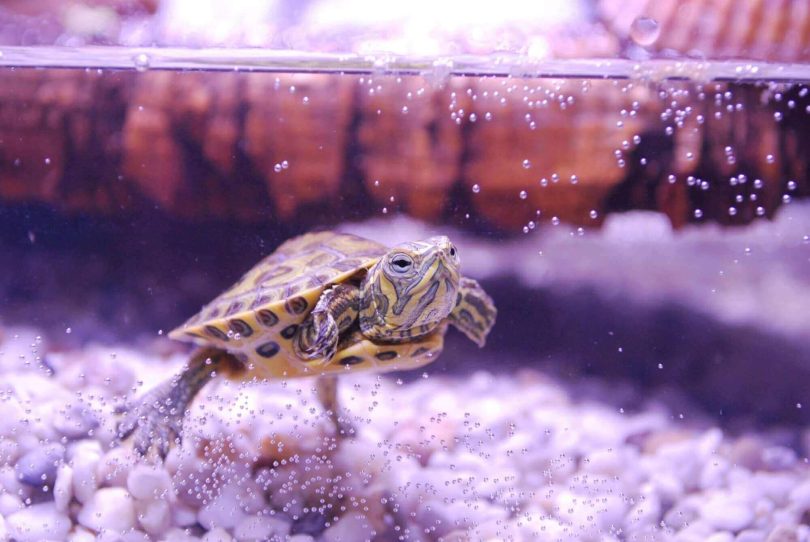Table of Contents
If you’re considering getting a pet turtle, one of the first questions you might have is whether you can keep it in a fish tank. After all, both turtles and fish are aquatic creatures, so it might seem like a logical choice. However, the answer is not as straightforward as you might think.
While it is possible to keep a turtle in a fish tank, there are several factors you need to consider before making this decision.
For example, turtles require more space than fish, and they also need a basking area where they can dry off and warm up.
Additionally, turtles produce more waste than fish, which means you’ll need to clean the tank more frequently.
In this article, we’ll explore the pros and cons of keeping a turtle in a fish tank, as well as some tips for creating a suitable habitat if you decide to go this route.
Turtles and Fish Tanks
If you are considering keeping a turtle as a pet, you may be wondering if it is possible to keep them in a fish tank.
While it is technically possible to keep a turtle in a fish tank, it is not always the best option. Here are some things to consider before making your decision:
Tank Size
Turtles require a lot of space to move around and explore. Most turtles will quickly outgrow a typical fish tank, which may lead to health problems and stress.
A general rule of thumb is to provide at least ten gallons of water per inch of turtle shell length. For example, if your turtle measures six inches from head to tail, you should provide at least 60 gallons of water.
Filtration
Turtles are messy creatures and produce a lot of waste. A good filtration system is essential to keep the water clean and healthy for your turtle.
A typical fish tank filter may not be sufficient to handle the amount of waste produced by a turtle. You may need to invest in a larger, more powerful filter to keep the water clean.
Lighting and Heating
Turtles require specific lighting and heating requirements to stay healthy. They need access to UVB lighting to help them metabolize calcium and vitamin D3, which are essential for their bone health.
They also need a basking area where they can climb out of the water and dry off. This area should be heated to around 90-95 degrees Fahrenheit.
Tankmates
While turtles can cohabitate with fish, it is not always a good idea. Turtles are natural predators and may view fish as food.
They may also harass or injure fish unintentionally while swimming around the tank. If you do decide to keep fish with your turtle, choose species that are fast-swimming and can avoid the turtle.
In conclusion, while it is possible to keep a turtle in a fish tank, it may not be the best option for their health and well-being.
If you do choose to keep a turtle in a fish tank, make sure to provide adequate space, filtration, lighting, heating, and choose tankmates carefully. Alternatively, consider a turtle-specific tank or outdoor enclosure that can better meet their needs.
Compatibility Factors
When considering putting a turtle in a fish tank, there are several compatibility factors you need to take into account.
Tank Size
The first and most important factor to consider is the size of the tank. Turtles need a lot of space to swim around and explore, so a small fish tank is not going to be suitable for them.
As a general rule of thumb, you should have at least 10 gallons of water for every inch of shell length of the turtle. So, if you have a 6-inch turtle, you would need a minimum of 60 gallons of water.
Water Quality
Turtles are messy creatures, and they produce a lot of waste. This means that you need to ensure that the water in the tank is kept clean and well-filtered. You should also perform regular water changes to keep the water quality high.
Temperature and Lighting
Turtles require specific temperature and lighting conditions to thrive. You will need to invest in a good quality heat lamp and UVB light to provide your turtle with the right conditions. The water temperature should also be maintained at a consistent level.
Tankmates
When it comes to tankmates, not all fish are suitable to live with turtles. Some fish may nip at the turtle’s fins or be too small to live alongside a turtle.
It is important to research the specific species of fish you want to keep with your turtle to ensure compatibility.
Diet
Turtles have a specific diet that needs to be adhered to. They require a mix of protein, vegetables, and fruits to stay healthy.
It is important to research the specific dietary requirements of your turtle and ensure that you are providing the right food.
In conclusion, putting a turtle in a fish tank requires careful consideration of several compatibility factors. These include tank size, water quality, temperature and lighting, tankmates, and diet.
By ensuring that you meet these requirements, you can provide your turtle with a safe and healthy environment to thrive in.
Tank Size
When setting up a tank for your turtle, it’s important to consider the size of the tank. The size of the tank you need depends on the size of your turtle and how many turtles you have.
As a general rule of thumb, the tank should be at least four times the length of your turtle and twice the width of your turtle. This will give your turtle enough space to swim around, bask, and explore.
If you have more than one turtle, you’ll need a larger tank. For each additional turtle, add at least 10 gallons of water to the tank. For example, if you have two turtles, you’ll need a tank that’s at least 80 gallons.
It’s also important to consider the depth of the water in the tank. The water should be deep enough for your turtle to swim and dive, but not so deep that they can’t touch the bottom. A good rule of thumb is to have the water level be at least twice the height of your turtle.
In addition to the size of the tank, you’ll also need to consider the type of tank you use. A fish tank may work for a small turtle, but larger turtles will need a more durable tank made of plastic or acrylic.
Overall, the size of your tank is crucial to the health and happiness of your turtle. Make sure to choose a tank that’s large enough for your turtle to move around in comfortably, and consider adding additional space if you have more than one turtle.
Water Quality
When it comes to keeping a turtle in a fish tank, water quality is a crucial factor to consider. Turtles produce a lot of waste, which can quickly deteriorate the water quality in a tank. Poor water quality can cause health problems for your turtle and other aquatic creatures in the tank.
To maintain good water quality, you should consider the following factors:
Filtration
A good filtration system is essential for maintaining clean and healthy water in your turtle’s tank. A filter helps remove waste, uneaten food, and other debris from the water.
There are several types of filters available, including canister filters, hang-on-back filters, and sponge filters. Choose a filter that is appropriate for the size of your tank and the number of turtles you have.
Water Changes
Regular water changes are necessary to keep the water clean and healthy. How often you should change the water depends on the size of the tank and the number of turtles you have.
As a general rule, you should change 25% to 50% of the water every two to four weeks. If you notice that the water is cloudy or has a foul odor, you should change the water immediately.
Water Temperature
Turtles are ectothermic, which means that they rely on their environment to regulate their body temperature.
The water temperature in your turtle’s tank should be between 75°F and 80°F. You can use a submersible heater to maintain the water temperature.
Water Quality Testing
Regular water quality testing is essential to ensure that the water in your turtle’s tank is healthy. You can use a water quality test kit to measure the levels of ammonia, nitrites, nitrates, and pH in the water. If you notice any abnormalities, you should take action immediately to correct the issue.
In conclusion, maintaining good water quality is crucial for keeping a turtle in a fish tank. By ensuring proper filtration, performing regular water changes, maintaining the correct water temperature, and testing the water regularly, you can provide a healthy and safe environment for your aquatic pets.
Diet and Feeding
When considering keeping a turtle in a fish tank, one of the most important aspects to consider is their diet and feeding habits.
Turtles are omnivores, which means that they need a balanced diet of both plant and animal matter to stay healthy and thrive.
In the wild, turtles eat a variety of foods, including insects, fish, crustaceans, and plants. When kept in a fish tank, it’s important to ensure that your turtle’s diet is varied and contains all the necessary nutrients.
One of the easiest ways to feed your turtle is by providing them with a commercial turtle food. These foods come in a variety of forms, including pellets, sticks, and flakes, and are formulated to provide a balanced diet for your turtle. Look for a food that contains a mix of animal and plant-based ingredients, as well as vitamins and minerals.
In addition to commercial food, you can supplement your turtle’s diet with fresh fruits and vegetables. Turtles enjoy a variety of foods, including leafy greens, carrots, squash, and berries. It’s important to chop these foods into small, bite-sized pieces to make them easier for your turtle to eat.
When feeding your turtle, it’s important to monitor their intake and adjust their diet as necessary. Overfeeding can lead to obesity and other health problems, while underfeeding can cause malnutrition.
A good rule of thumb is to feed your turtle a small amount of food once a day, and remove any uneaten food after 15-20 minutes.
Overall, providing your turtle with a varied and balanced diet is crucial to their health and well-being. By including both commercial food and fresh fruits and vegetables in their diet, you can ensure that your turtle is getting all the necessary nutrients they need to thrive.
Behavior and Interactions
When considering whether to put a turtle in a fish tank, it’s important to understand their behavior and interactions.
Turtles are fascinating creatures that can make great pets, but they also have specific needs that must be met to ensure their health and happiness.
Turtles are generally solitary animals that prefer to spend most of their time in the water. They are active during the day and sleep at night, and they require a basking area to dry off and warm up. When kept in a fish tank, it’s important to provide them with plenty of space to swim and a basking area that they can easily access.
Turtles are also known to interact with their environment, including other animals in the tank. They may chase after fish or other small creatures, and they may also try to climb on top of or interact with decorations or plants in the tank.
It’s important to monitor their interactions and make sure that they are not causing harm to themselves or other animals in the tank.
If you plan on keeping a turtle in a fish tank with other animals, it’s important to choose compatible species. Some fish may be aggressive towards turtles, while others may be too small to safely coexist with them.
It’s important to research the specific needs and behaviors of each species and ensure that they can live together peacefully.
Overall, turtles can make great additions to a fish tank, but it’s important to understand their behavior and interactions to ensure their health and happiness.
Providing them with plenty of space, a basking area, and compatible tank mates are important factors to consider when deciding whether to put a turtle in a fish tank.
Conclusion
In conclusion, while it is possible to keep a turtle in a fish tank, it is not recommended for several reasons.
Firstly, turtles require a lot of space to swim and move around, and most fish tanks are not large enough to provide adequate space for them. This can lead to stress, which can cause health problems for the turtle.
Secondly, turtles produce a lot of waste, which can quickly build up in a fish tank and lead to poor water quality. This can cause health problems for both the turtle and any fish that may be sharing the tank.
Thirdly, turtles require a basking area where they can climb out of the water and dry off. Most fish tanks do not have an area like this, which can cause the turtle to become stressed and unhealthy.
Finally, turtles have specific dietary needs that must be met in order for them to thrive. While some turtles may eat fish, others require a more varied diet that includes vegetables and other foods. It can be difficult to provide the right diet for a turtle in a fish tank.
Overall, while it may be tempting to keep a turtle in a fish tank, it is not recommended. If you are considering getting a turtle as a pet, it is best to provide them with a proper enclosure that meets their specific needs. This will ensure that they are happy and healthy for years to come.







